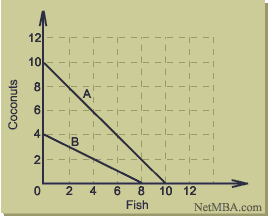Economics > Comparative Advantage
David Ricardo and
Comparative Advantage
In his 1817 book, On the Principles of Political Economy and Taxation, David Ricardo used the example of Portugal and England's trading of wine and cloth to illustrate the benefits of specialization and trade. His writing served as the basis for the principle of comparative advantage, under which total output will be increased if people and nations engage in those activities for which their advantages over others are the largest or their disadvantages are the smallest.
Imagine two individuals, A and B, living on a remote island. Two goods are needed and produced: coconuts and fish. Person A has an absolute advantage in the production of both goods, able to produce more coconuts than B and more fish than B. Their production capabilities are summarized in the following table:
Output Alternatives
Coconuts | V |
Fish | V |
|
A --> |
10 |
10 |
B --> |
4 |
8 |
Note that the numbers in the above table indicate the maximum amount of one commodity that could be produced assuming the individual produced none of the other commodity. For example, if A decided to harvest 10 coconuts, then A would not be able to catch any fish. Similarly, if B decided to catch 8 fish, then B would not be able to harvest any coconuts. The values represent the endpoints of each individual's production possibility frontier. For this discussion, we will assume that each production possibility frontier is linear as shown below.
Production Possibilities for A and B

If the individuals did not trade, then each would produce both coconuts and fish. For example, if each spent half of his or her time harvesting coconuts and the other half catching fish, the output from A would be 5 coconuts and 5 fish, and the output from B would be 2 coconuts and 4 fish. The total combined output then would be 7 coconuts and 9 fish.
Since both A and B must make trade-offs in their production decisions, they each have an opportunity cost for each commodity they produce:
Opportunity cost of coconuts
- A: 1 fish per coconut. (10 fish per 10 coconuts.)
- B: 2 fish per coconut. (8 fish per 4 coconuts.)
Opportunity cost of fish
- A: 1 coconut per fish. (10 coconuts per 10 fish.)
- B: 0.5 coconut fish. (4 coconuts per 8 fish.)
Since the opportunity cost of coconuts is lower for A than for B, one can say that A has a comparative advantage in producing coconuts, so A should produce coconuts to maximize the island's output.
Since the opportunity cost of fish is lower for B than for A, one can say that B has a comparative advantage in producing fish, so B should produce fish to maximize the island's output.
If A produces coconuts and B produces fish, then the total combined output would be 10 coconuts and 8 fish. (versus 7 coconuts and 9 fish without specialization.) From this example, it might not be immediately obvious that the individuals are better off - while they have gained 3 coconuts they at the same time have lost one fish. However, A easily can choose to produce 9 coconuts and one fish, so that the combined output becomes 9 coconuts and 9 fish. Compared to the case of no specialization, there is a net gain of 2 coconuts with no loss of fish. By trading with one another, the two individuals can distribute the goods according to their preferences, and both are better off as a result of their specialization and trading.
The effect of specialization and trade is an expansion of the production possibilities for the individuals. Even though A has an absolute advantage over B for both commodities, they both benefit by specializing and trading.
Economics > Comparative Advantage


